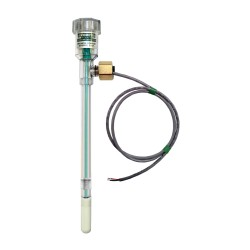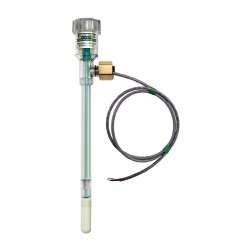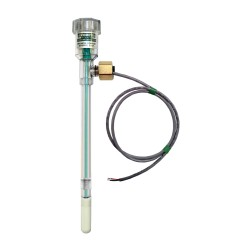
Irrometer LT Long Tensiometer
Professional long-range tensiometer for measuring soil water tension in deep root zones. Essential for orchards, vineyards, and monitoring deep percolation and drainage.
Product Highlights
View all in Specifications tabOverview
The Irrometer LT (Long Tensiometer) is a professional-grade instrument designed for monitoring soil water tension at deep root zone depths of 36-48 inches (90-120 cm). This long-range model is essential for tracking deep water storage, monitoring drainage and deep percolation, ensuring complete root zone wetting in orchards and vineyards, and preventing water waste through over-irrigation.
Key Features
- Deep Zone Monitoring: Measures soil moisture at 36-48 inch (90-120 cm) depths
- Direct Measurement: Measures actual soil water tension experienced by deep roots
- Drainage Detection: Identifies over-irrigation and deep percolation losses
- Fast Response: Rapid equilibration with soil moisture changes
- Easy Reading: Clear vacuum gauge with centibar scale
- Proven Technology: Time-tested design used worldwide since 1951
- No Calibration: Works in all soil types without calibration
- Professional Grade: Durable construction for long-term field use
Applications
- Deep-rooted orchard crops (citrus, stone fruit, pome fruit)
- Mature vineyard irrigation management
- Deep percolation monitoring
- Drainage assessment
- Complete profile irrigation verification
- Water storage zone monitoring
- Over-irrigation detection
- Preventing groundwater contamination
- Agricultural research
- Water balance studies
- Multi-depth soil moisture profiling
Technical Specifications
The Irrometer LT tensiometer features an extended-length water-filled tube with a porous ceramic cup positioned at the deep measurement depth. Water exchanges through the ceramic cup in response to soil moisture conditions at that depth, creating a vacuum measured by the gauge at the surface. The reading indicates soil water tension where deep roots access water and where excess irrigation causes drainage losses.
Understanding Deep Zone Monitoring
The deep root zone and drainage zone serve critical functions:
Deep Root Water Access
- Drought reserve: Water available during extended dry periods
- Mature plant roots: Established trees and vines access deep water
- Deep watering verification: Confirms irrigation reaches entire root zone
- Root zone extent: Indicates active root zone depth
Drainage and Water Loss Detection
- Over-irrigation indicator: Shows when excess water percolates below roots
- Water efficiency: Identifies wasted irrigation water
- Nitrate leaching: Deep percolation carries nutrients below root zone
- Environmental protection: Prevents groundwater contamination
- Cost savings: Reduces wasted water, energy, and nutrients
Tensiometer Reading Interpretation
Deep Zone Moisture Status
- 0-10 cb: Recent deep percolation, possible over-irrigation
- 10-30 cb: Deep zone well-watered, full profile wetting achieved
- 30-50 cb: Adequate deep moisture reserve
- 50-70 cb: Deep reserve depleting, ensure adequate irrigation depth
- 70-80 cb: Deep zone dry, roots may be stressed if shallow zones also dry
Multi-Depth Comparison Patterns
Pattern 1: Shallow and mid wet, deep dry
- Irrigation not penetrating deep enough
- Increase irrigation duration
- May indicate irrigation system limitations
- Check for soil layers restricting downward water movement
Pattern 2: All depths wet including deep
- Excellent irrigation - complete profile wetting
- Or possible over-irrigation if deep remains wet too long
- Monitor deep zone - should dry between irrigations
Pattern 3: Deep wet after irrigation, stays wet
- Over-irrigation - water wasted below root zone
- Reduce irrigation amount or frequency
- Causing nutrient leaching and water waste
Pattern 4: Deep dry, mid and shallow also dry
- Inadequate irrigation for extended period
- Irrigate promptly with adequate amount
- Consider deficit recovery irrigation strategy
Pattern 5: Deep wet continuously, shallow cycling
- Indicates water table presence or restricted drainage
- May affect crop selection and irrigation strategy
- Consider drainage improvement if problematic
Installation Guidelines
Selecting Installation Depth
The LT model is designed for deep zone depths:
- Mature orchards: 90-120 cm (36-48 inches)
- Established vineyards: 90-105 cm (36-42 inches)
- Drainage monitoring: Below typical root zone
- Deep-rooted crops: Within deepest active root zone
Installation Procedure
- Auger deep hole: Use extension auger to reach required depth
- Verify depth: Measure auger depth carefully
- Prepare thick slurry: Mix native soil with water to thick consistency
- Fill hole completely: Pour slurry to fill entire depth
- Insert tensiometer: Push firmly, working through slurry to bottom
- Confirm depth: Measure exposed tube to verify cup at target depth
- Fill with water: Remove cap and fill tube to near top
- Remove air bubbles: Tap tube firmly to release trapped air
- Top off water: Refill after air removal
- Seal: Replace and tighten cap securely
- Mark and protect: Flag location, protect exposed tube from damage
- Equilibrate: Wait 48-72 hours for deep zone equilibration
Special Installation Considerations
- Soil auger: Requires longer auger than standard
- Physical effort: Deep installation requires more effort
- Slurry consistency: Must be thick enough to support long installation
- Tube protection: Exposed tube longer, needs protection from equipment
- Location marking: Critical to mark well - easy to lose in field
- Access: Ensure accessible for regular monitoring
Reading and Maintenance
Monitoring Schedule
Frequency depends on use:
- Complete profile monitoring: Read with shallow and mid depths
- Drainage detection: Check 24-48 hours after irrigation
- Deep reserve tracking: Weekly during dry periods
- Research applications: Daily or as needed
Maintenance Requirements
Weekly Maintenance:
- Check water level in tube (inspect near top)
- Look for damage to exposed tube
- Verify gauge function
- Record readings
Bi-weekly Maintenance:
- Top off water if level dropped
- Check for air bubbles
- Tap tube if needed to release air
- Inspect cap seal
Monthly Maintenance:
- Remove cap and refill completely
- Check gauge accuracy
- Inspect for physical damage
- Verify tube integrity
Seasonal Maintenance:
- Deep tensiometers may need more frequent refilling
- Clean ceramic cup if response slows
- Replace water completely
- Check all connections and seals
Refilling Deep Tensiometers
Deep tensiometers use more water through the longer tube:
- Check water level weekly
- Remove cap when water level drops significantly
- Fill completely to near top
- Tap tube vigorously to release air bubbles
- Top off after air removal
- Replace cap securely
- Monitor gauge returns to reading (may take longer at depth)
Multi-Depth Monitoring Strategy
Three-Depth System (Recommended)
Shallow (SR, 6-12”):
- Primary root activity zone
- Quick irrigation response
- Triggers irrigation timing
Mid (MLT, 18-24”):
- Water storage zone
- Verifies irrigation penetration
- Monitors profile wetting
Deep (LT, 36-48”):
- Deep storage monitoring
- Drainage detection
- Over-irrigation warning
- Deep root zone for mature plants
Benefits of Including Deep Monitoring
- Complete picture: Full root zone moisture profile
- Prevent water waste: Detect over-irrigation early
- Optimize application: Apply right amount, not excess
- Environmental protection: Prevent nitrate leaching
- Cost savings: Reduce wasted water and nutrients
- Mature plant management: Ensure deep roots have water access
- System evaluation: Verify irrigation system performance
Interpreting Deep Zone Behavior
Normal Patterns
- Responds slower than shallow: Normal due to depth
- Stays drier longer: Less evapotranspiration at depth
- Wets after shallow/mid: Water takes time to percolate down
- Buffer effect: Changes less rapidly than surface
Warning Signs
- Frequent wetting: May indicate over-irrigation
- Never dries: Possible water table or excessive irrigation
- No response to irrigation: Water not reaching this depth
- Extremely dry when others wet: Irrigation insufficient
Orchard and Vineyard Applications
Mature Trees
- Deep roots access water at 3-4 feet depth
- LT monitors this critical zone
- Ensures irrigation reaches entire root system
- Prevents deep stress in drought
Regulated Deficit Irrigation (Vineyards)
- Monitor controlled stress at depth
- Manage water stress for quality
- Ensure stress not excessive
- Maintain adequate deep reserves
Young Tree Establishment
- Initially may show little response
- As roots grow deeper, becomes more useful
- Helps encourage deep rooting
- Monitors irrigation depth increase as trees mature
Drainage and Water Quality
Over-Irrigation Detection
Deep tensiometer alerts to over-irrigation when:
- Readings stay consistently wet (0-20 cb)
- Wets immediately after every irrigation
- Never dries between irrigations
- Indicates water waste and nutrient leaching
Environmental Benefits
Preventing deep percolation protects:
- Groundwater quality: Reduces nitrate contamination
- Water resources: Prevents waste of irrigation water
- Energy: Reduces pumping for excess water
- Soil health: Maintains optimal soil structure
Troubleshooting Deep Tensiometers
Gauge Stays at Zero:
- May indicate saturated zone or water table
- Check mid and shallow readings for context
- Could indicate excessive irrigation
- Verify cup not installed in water table
Very Slow Response:
- Normal for deep installation - allow more time
- May need 48-72 hours to respond to irrigation
- Check shallower tensiometers respond first
- Verify water actually reaching this depth
Gauge Stays at 80 cb:
- Deep zone very dry (may be normal)
- Check shallow and mid for context
- If all dry, irrigate promptly
- If shallow/mid adequate, may indicate insufficient depth
Different from Shallower Depths:
- Normal - depth differences expected
- Use pattern for irrigation assessment
- Indicates water distribution profile
- Key information for irrigation management
Advanced Applications
Water Balance Studies
- Monitor deep drainage component
- Measure water losses below root zone
- Calculate irrigation efficiency
- Research water use patterns
Irrigation System Evaluation
- Verify system applies enough water for complete wetting
- Detect distribution problems
- Assess system capacity adequacy
- Evaluate emitter/sprinkler performance
Soil Characterization
- Identify soil layering affecting water movement
- Detect restrictive layers
- Assess drainage characteristics
- Understand soil water dynamics
Climate Adaptation Research
- Monitor deep soil water reserves
- Study root depth changes
- Evaluate deficit irrigation strategies
- Assess water conservation practices
Seasonal Management
Spring
- Reinstall after winter storage
- Monitor soil profile recharge from winter rain
- Establish baseline for coming season
- Adjust depths if needed
Summer
- Critical period for deep zone monitoring
- Watch for over-irrigation
- Verify adequate irrigation depth
- Monitor deep reserves during peak demand
Fall
- Track seasonal moisture changes
- Monitor deep zone as irrigation reduces
- Prepare for winter removal in cold climates
- Document season performance
Winter
- Remove in freezing climates
- Clean and inspect all components
- Store cups submerged in water
- Plan next season strategy
Economic and Environmental Benefits
Water Savings
- Detect and eliminate over-irrigation
- Reduce deep percolation losses
- Save 15-30% of water through deep monitoring
- Lower pumping costs
Fertilizer Efficiency
- Prevent nitrate leaching below root zone
- Improve nutrient use efficiency
- Reduce fertilizer costs
- Protect groundwater quality
Crop Performance
- Ensure deep roots have water access
- Prevent deep stress in mature plants
- Optimize water distribution
- Improve drought resilience
Professional Use
Essential for:
- Commercial orchard managers
- Vineyard irrigation specialists
- Agricultural consultants
- Water management districts
- Irrigation system designers
- Research scientists
- Environmental agencies
- Teaching and demonstration
Quality and Support
Irrometer LT tensiometers feature:
- Made in USA
- Quality tested
- Proven field durability
- Replaceable parts available
- Technical support
- Over 70 years of innovation
- Extensive documentation and resources
Related Products
Other solutions in the soil category


